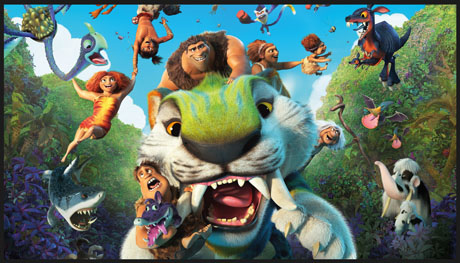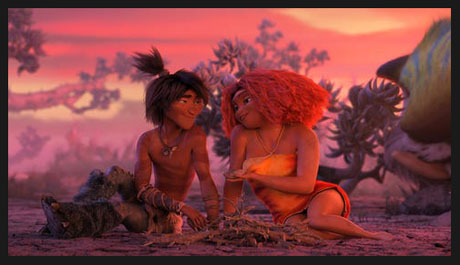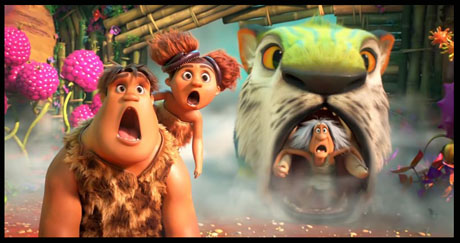
Seven years following the 2013 DreamWorks movie The Croods, the sequel finally found its way to theaters and home streaming. The good news: not only is C2 a better movie than its predecessor, but it’s also a damn sight funnier, warmer, and fun to watch. While superior in its visual effects, the original film was formulaic, predictable, and less than the sum of its parts. C2 has it’s parts scattered left and right, but nicely coheres into a check-you-brain-at-the-door thrill ride, heavy on visual gags, outrageous facial contortions, and physical comedy that for once does not include a single fart joke.

C2 is the kind of film that, unless you are determined to force your critical skills upon viewing it, defies any sort of analysis. There’s a plot, all right, but it is nearly superfluous to the film. The story is part comedy of manners, part wild farce, part class-based comedy, part superhero satire, and part comic commentary on society’s divisions. These elements are tossed into a high-speed blender by Director Joel Crawford after being handed them by scriptwriters Kevin and Dan Hagerman, Paul Fisher, and Robert Logan.
Be warned: This film does not rest for a moment of its running time, reeling off sight and dialogue-based gags with very few lulls or lags. Hit the pause button if you need a bathroom break since you’ll probably miss at least ten of them. Also be warned: you will be amused by much of what you see. C2 is an interesting contrast with its contemporary, Soul. The former film mixed deep questions about life and its purpose with gentle humor and then pursued them through an affecting (if carelessly written) story. C2 is anarchic bombast where the most profound question is why bananas are so vital, and the humor is far from gentle…or genteel. To be very honest, I was wowed by the virtuosity of Soul, but its inconsistencies and holes weighed it down, and I enjoyed romping with C2 more.
Despite finding a paradise at the end of the first movie, the Croods are off searching for better digs. They include patriarch Grug (Nicholas Cage), spouse Ugga (Catherine Keener), and teen daughter Eep (Emma Stone), who is goofy with love for outsider Guy (Ryan Reynolds). They dream of setting up their own clan. The other Croods reprising roles are slacker son Thunk (Clark Duke), toddler Sandy, and Grandma “Gran” (Cloris Leachman). In a short prelude, we get Guy’s backstory, whose parents were lost in an unfortunate tar pit accident.

The Croods come across a cultivated paradise in which colorful food grows in abundance. It turns out to be the walled-in property of the Betterman family, a more advanced version of Homo Erectus. Led by Daddy Phil (Peter Dinklage) and consisting of spouse Hope (Leslie Mann) and teen daughter Dawn (Kelly Marie Tran), the Bettermans reside in a sprawling tree palace featuring beds, showers, flush toilets, and space for creative and culinary arts. It also turns out that the family took in Guy after he was orphaned.
In short, there’s a great culture clash that eventually comes down to the Bettermans wanting to marry off Guy to Dawn, while a heartbroken Eep is backed by her clan. To the film’s credit, Dawn and Eep do not become rivals; for a good portion of the movie, they are unaware of the machinations going on behind their backs. Instead, they become rollicking buddies and share a few wild adventures before the denouement.
In this movie, spoilers are superfluous, so, oh yes, those bananas I mentioned. To Grug’s confusion, they are forbidden fruit. He doesn’t know that they have been reserved for the punch monkeys (small simians who communicate through physical violence that Moe Howard would appreciate). The punch monkeys, in turn, are slaves of a King-Kong-sized cross between a mandrill and a porcupine, and they appease him with the bananas. When Grug defies Phil by gorging on the pile of sacrificial bananas, there’s surely trouble ahead.
When the punch monkeys substitute Grug, Phil, and Guy as the sacrifice, they are rescued by the women after Gran transforms them into the ancient female warrior cadre known as the Thunder Sisters. Each one, even Sandy, gets face paint, a superhero name, and an introductory comic-book-type splash panel!) They defeat the giant ape, with Eep and Guy delivering the coup de gras. The film ends with the families living in harmony. The chastised parents on both sides warmly watch Eep and Guy venture out to start their own clan.

The performances rock (so to speak). Peter Dinklage does a credible turn as the breezy manipulative character who could be called Early California Man (complete with man-bun). Leslie Mann, in an outstanding performance, balance condescension and self-shame at her own intolrrance. Kelly Marie Tran is a pile of enthusiasm as Dawn, but her best performance is in a scene where she becomes loopy from bee venom. The original Croods all return from 2013 and are as outstanding as they were in the original film. Cloris Leachman is given a larger turn as Gran, especially after she resumes her long-lost leadership of the Thunder Sisters and plays her scene like a geriatric, avenging Wonder Woman.
The entire ensemble interacts well, and the comic tensions between the Crude Croods and the sophisticated Bettermans underscore every scene to definite effect. Much of it is expressed through the interactions of Grug and Phil. There are no villains in this film; Both adult couples are at fault for believing they know what’s best for their kids while ignoring what is going on in plain sight; Eep and Guy are deeply in love, and Dawn is not all that interested in hooking up with Guy in the first place.
Are we not cavemen? Ex-Devo frontman Mark Mothersbaugh, who seemingly scores every animated film outside Disney’s, gives a workmanlike effort and not much more. Still, there are a few scenes when the score pops. The visuals are not as detailed or realistic as in the first film (C2 actually cost less to make), but there is little in the wild color palette for DreamWorks to be ashamed of. The studio has always had a quirk in animating eyes; they tend (especially in close-up) to have a shiny, glassy look, and that problem remains.
The film’s subtext is that it’s better to fight for each other than against each other, no matter what differences in class or manners there may be. But who cares about that? After trying to reconcile Soul’s story errors, parsing out something resembling a plot in Pokemon Detective Pikachu, or suffering through the unholy blasphemy of Arctic Dogs (to cite recent examples), I got considerable pleasure from forgetting about critical bromides. I just had fun watching a wild-ass animated movie. I invite you to do the same.
- ANIME REVIEW: “Lonely Castle in the Mirror” - September 24, 2023
- REVIEW: “Teenage Mutant Ninja Turtles: Mutant Mayhem - August 15, 2023
- REVIEW: “Spider-Man: Across The Spider-Verse” - June 7, 2023


 January 4th, 2021
January 4th, 2021  Martin Goodman
Martin Goodman  Posted in
Posted in  Tags:
Tags: 






